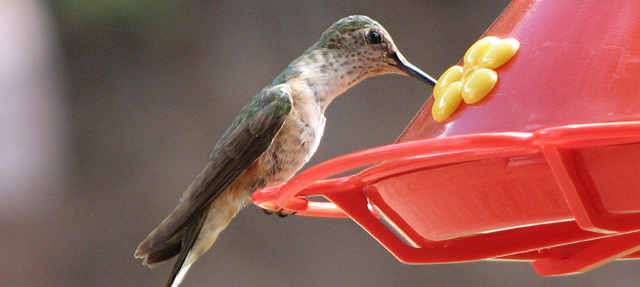Each year here in Inman, we see one or two hummingbirds in the spring or in the fall, then we’ll hustle to get a feeder up but never see them again. Three weeks ago, the scenario repeated itself, we put up a couple feeders, and three of the little buggers have been regularly slurping sugar water every day since. In researching hummingbird “gurus” here in KS, I was told to contact Chuck Otte, Agriculture and Natural Resources Agent for Geary County.
Chuck told me both his mother and grandmother were avid bird watchers. He says “I was predisposed as early as four years old to be an avid “birder” like them, and now backyard “birding” is my passion.” He says that hummingbirds here in KS “leisurely” begin meandering south in late July; the adult males first, followed by the adult females then this-years young. Otte also says winds and weather fronts & patterns help determine when they leave for their winter digs in southern Mexico or northern Central America. I just assumed they would all go together in one large group, especially so the youngsters could safely follow, but he says that’s not the case.
Here in the Hutchinson area, we are in a transition zone that runs north clear to North Dakota, putting us on the very western edge of the Ruby-Throated Hummingbirds range, but they are still the most likely species we’ll see. West of us, the Rufous, Broad-tailed, Black-chinned and Calliope species are more prevalent, and being this close to the edge of their boundaries, it’s possible to see some of those species around our area too.
When talking hummingbirds, feeding them always enters the discussion, and Otte had lots of advice. He advises feeding hummingbirds straight sugar water, mixed one-part sugar to four parts water; NO red food color, NO honey, NO sugar substitutes or other additives, just straight sugar water. Don’t mix the syrup stronger than that as hummingbirds get most of their water from the syrup they drink. They are attracted to the color red, so it may be helpful if the feeder is red, but avoid yellow on the feeder as yellow attracts bees and wasps. Put the feeders up in mid-April for the hummers’ arrival and take them down in early June. If you continue seeing a couple birds after that, they are possibly nesting nearby and leaving a feeder up will benefit them. Otherwise, put feeders back up around July 20, and leave them up till the little guys leave in early October. Otte says while there is obviously no guarantee the same hummers will visit you next year, Ruby-throated hummingbirds do remember where they feed in the fall. He also debunked the theory that leaving feeders up longer in the fall will coerce hummingbirds to stay too late, putting their migration in peril. Otte says their instinct and drive to migrate and to leave when they need to leave is stronger than anything we humans can do to keep them here.
Natural attracters can also help draw and possibly keep hummingbirds near your garden. Plants with red or bright orange cone-shaped flowers that produce lots of nectar are especially noticed by hummingbirds. Salvia, red Cannas, Hollyhocks and Trumpet vine are all good. Another fact new to me is that hummers’ need to eat small insects for protein, so as they flit amongst your flowers, they are also looking for snacks besides just nectar.
I won’t get into hummingbird trivia here, like how fast their little hearts beat or how fast their tiny delicate wings move, but I challenge you to watch one for any length of time without finding yourself completely in awe of God’s handiwork the day He Created hummingbirds.
Steve can be contacted by email at [email protected].





